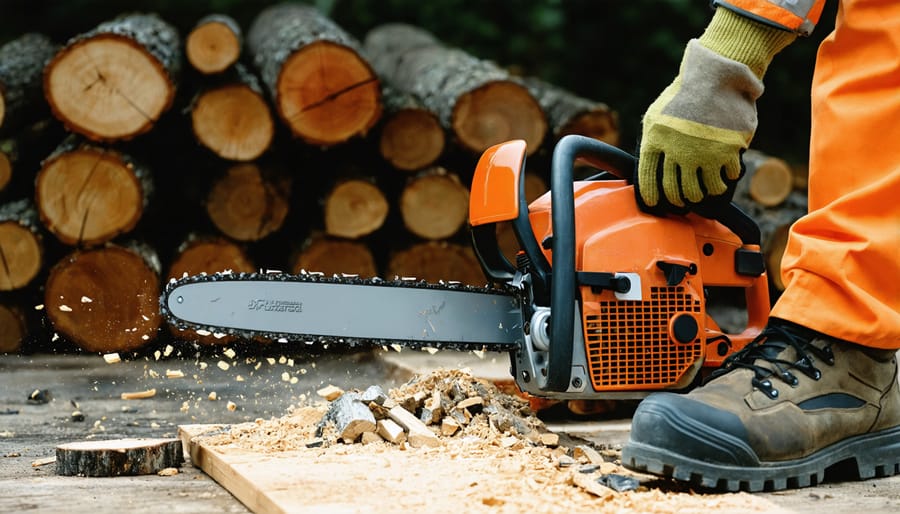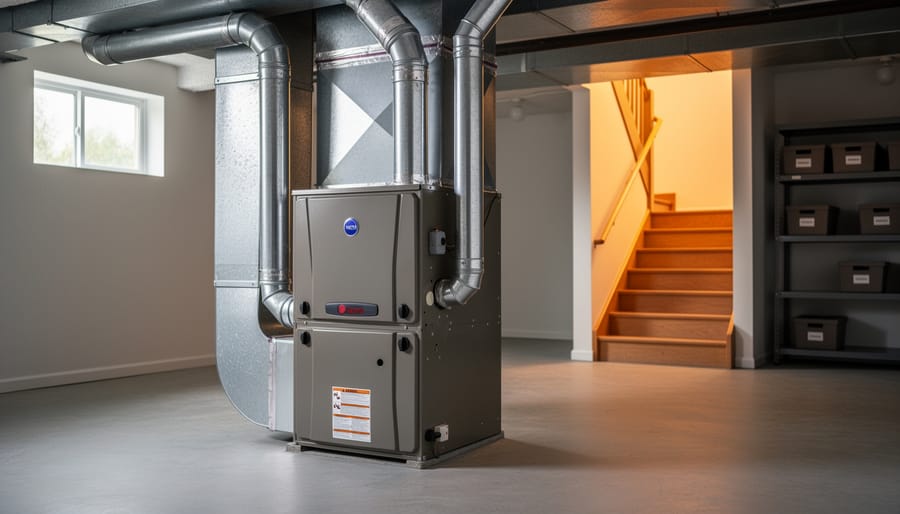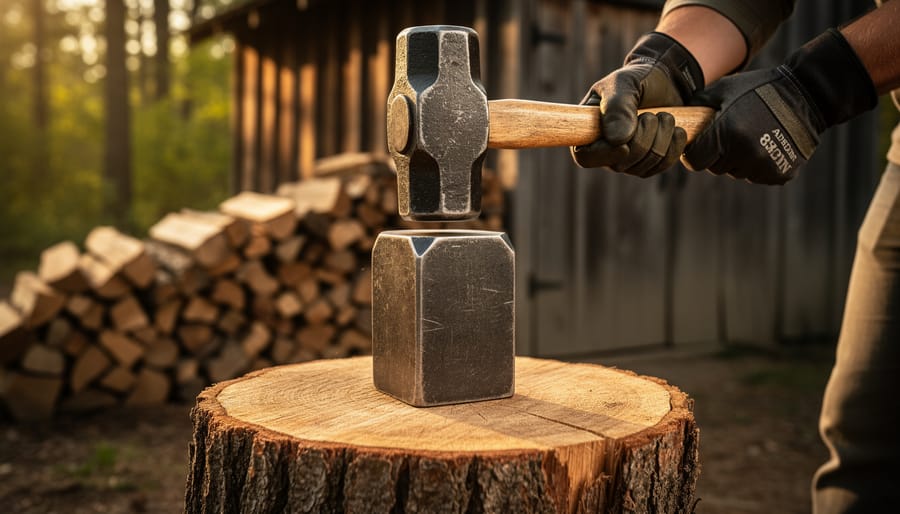Transform your firewood preparation with the raw power and efficiency of a chainsaw – a modern evolution beyond traditional wood splitting methods. While axes and mauls have their place, chainsaw splitting techniques can reduce hours of labor to minutes when properly executed.
Master this advanced method by understanding three critical elements: proper log positioning on a stable, elevated surface; precise chainsaw handling with controlled downward cuts; and strategic splitting patterns that work with, not against, the wood’s natural grain. This approach combines safety with efficiency, allowing you to process more firewood in less time while minimizing physical strain.
Whether you’re preparing for winter or maintaining a year-round wood supply, chainsaw splitting offers a practical solution for homeowners seeking to maximize their firewood production. With the right technique and safety precautions, you’ll transform logs into perfectly sized fireplace fuel while preserving both your energy and time.
Remember: This method requires specific safety gear, proper chainsaw maintenance, and careful attention to technique – but the results are worth the investment in learning to do it right.
Essential Safety Gear and Preparation

Required Safety Equipment
When splitting wood with a chainsaw, your safety gear is non-negotiable. Start with a well-fitted safety helmet that includes a face shield and ear protection – this trio protects your head from falling debris while keeping your face safe from flying wood chips and your ears from damaging noise levels.
Your hands need reliable protection with chainsaw-specific gloves that offer both grip and cut resistance. Steel-toed boots are essential to shield your feet from falling logs and provide stable footing while you work.
Chainsaw chaps or protective pants are crucial as they’re designed to jam the chain if contact occurs, potentially saving you from severe injury. A snug-fitting long-sleeve shirt and work pants will guard against scratches and debris, while safety glasses beneath your face shield provide an extra layer of eye protection.
Keep a well-stocked first aid kit nearby, and never work alone – having someone within earshot but at a safe distance adds an important layer of security to your wood-splitting operation. Remember, proper safety gear isn’t just about protection – it gives you the confidence to focus on the task at hand.
Chainsaw Inspection and Maintenance
Before you begin splitting wood, it’s crucial to ensure your chainsaw is in optimal working condition. Start by checking the chain tension – it should be snug against the guide bar but still move freely when pulled by hand. A chain that’s too loose or too tight can be dangerous and inefficient.
Next, inspect the chain’s sharpness. Dull chains not only make the work harder but also increase the risk of accidents. Look for signs of wear on the cutting teeth and ensure they’re all uniformly sharp. The depth gauges should be at the correct height for safe, efficient cutting.
Check your chainsaw’s oil levels and fill both the bar oil and fuel tanks as needed. Clean air filters are essential for proper engine performance, so remove and clean or replace them if necessary. Examine the guide bar for any damage or excessive wear, particularly around the nose and rails.
Don’t forget to test the chain brake and throttle lockout – these safety features must work perfectly. Regular maintenance not only extends your chainsaw’s life but also ensures safer, more effective wood splitting sessions.
Setting Up Your Wood Splitting Station
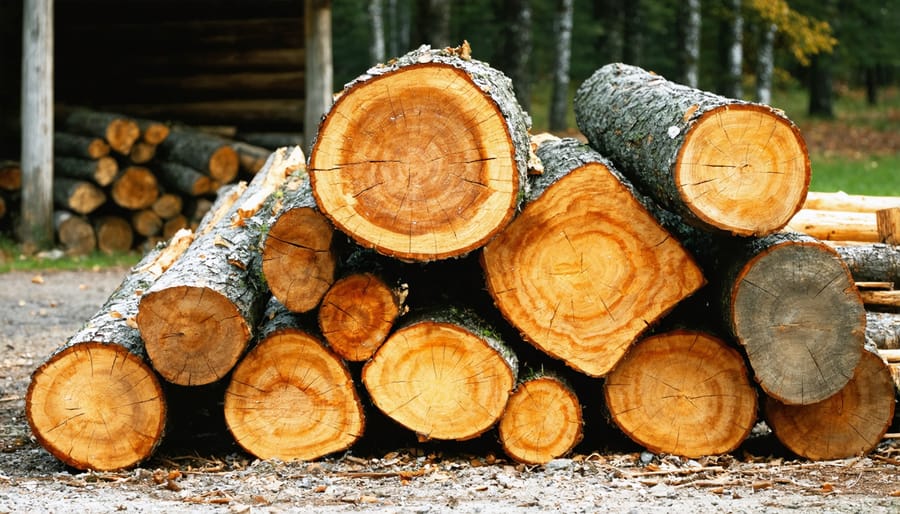
Choosing the Right Location
Setting up the right location for splitting wood with a chainsaw is crucial for both safety and efficiency. Choose a flat, level surface that’s free from obstacles, ideally on packed dirt or gravel. Avoid splitting wood on concrete or asphalt, as these surfaces can damage your chainsaw chain if contact is made.
Ensure you have plenty of space around your work area – at least 10 feet in all directions. This buffer zone helps prevent accidents and gives you room to maneuver. Clear the area of any tripping hazards like branches, tools, or debris. Good footing is essential for maintaining control while operating your chainsaw.
Consider working in an area with good natural light, but avoid direct sunlight that might impair your vision. If possible, position yourself so that any wind blows sawdust away from you. Your splitting location should also be easily accessible for moving the split wood to your storage area.
Keep children and pets away from the work zone, and make sure your setup allows for a clear escape path in case of emergency. Working near your woodshed or final storage location can minimize the effort needed to transport split wood afterward.
Log Positioning Techniques
Proper log positioning is crucial for safe and effective wood splitting with a chainsaw. Start by selecting a stable, level surface away from obstacles and other people. Place your log on a sturdy cutting block or platform that’s approximately knee height – this reduces back strain and gives you better control over the chainsaw.
For shorter logs (under 20 inches), position them vertically on your cutting surface. Ensure the log stands firmly and doesn’t wobble. If needed, use small wooden wedges to stabilize it. For longer pieces, you’ll want to split them horizontally, but never directly on the ground. Instead, support the log at both ends using sawhorses or additional logs, leaving the section you’re cutting suspended in the middle.
Always position yourself at a comfortable angle to the log, maintaining solid footing with your feet shoulder-width apart. The log should be between you and the chainsaw’s bar, allowing for a natural cutting motion. Remember to keep the log’s center of gravity low and watch for any signs of instability during cutting. If a log feels unstable, stop and reposition it before continuing.
Chainsaw Splitting Techniques
The V-Cut Method
The V-cut method is one of the most effective techniques for splitting wood with a chainsaw, offering an alternative to other wood splitting tools. This approach involves making two angled cuts that meet to form a “V” shape in the log, using gravity and the wood’s natural grain to your advantage.
Start by positioning your log securely on a stable cutting surface, preferably a dedicated sawbuck or sturdy work platform. Make your first cut at approximately a 45-degree angle, penetrating about one-third of the way through the log. Then, create a second cut from the opposite direction, angling your chainsaw to meet the first cut at its deepest point.
The key to a successful V-cut lies in the precision of these two intersecting cuts. As they meet, the wood’s natural tension will often cause it to split apart with minimal additional effort. For particularly stubborn pieces, you may need to make your cuts slightly deeper or adjust the angle to better work with the wood’s grain pattern.
Remember to maintain steady control of your chainsaw throughout the process and let the weight of the tool do the work. Avoid forcing the cuts, as this can cause the chainsaw to bind or kick back. If you’re dealing with especially large logs, consider making multiple V-cuts along the length of the wood for more manageable pieces.
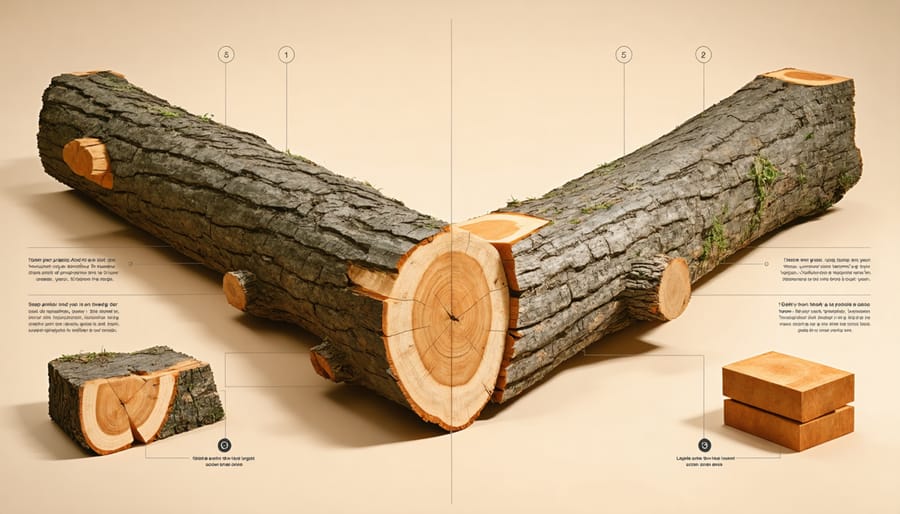
Cross-Cutting Large Logs
When faced with logs too large for your standard splitting techniques, cross-cutting becomes essential. Begin by ensuring the log is firmly supported on both ends, leaving the section you’ll cut suspended in the middle. This prevents the chainsaw from binding and reduces the risk of kickback.
Start by making a downward cut about one-third through the log’s diameter. Next, roll the log slightly and make a second cut from the top, meeting your first cut. This technique, known as plunge cutting, helps maintain control while working with oversized logs.
For extremely large logs, consider making multiple cuts in a grid pattern. Make parallel cuts about 6-8 inches apart across the log’s diameter, then rotate the log 90 degrees and repeat the process. This creates smaller, more manageable sections that are easier to split further if needed.
Always be mindful of where the log might fall when making your final cuts. Position yourself on the uphill side when working on a slope, and ensure your cutting area is clear of obstacles. Remember that larger logs are heavier and can shift unexpectedly, so maintain a stable stance and keep your footing secure throughout the process.
For the best results, work systematically and take breaks as needed. Large logs require more time and energy, so pace yourself and prioritize safety over speed.
Dealing with Different Wood Types
Different wood species present unique challenges when splitting with a chainsaw, and understanding these variations can make your work more efficient. Softwoods like pine and cedar generally split more easily due to their straight grain and less dense structure, making them ideal for beginners. However, they may produce more sawdust and require more frequent blade sharpening.
Hardwoods such as oak, maple, and hickory demand more power and patience. Their dense fibers and complex grain patterns can make splitting more challenging, but they provide longer-burning firewood that’s perfect for sustained heat. While splitting mauls and axes might be traditional choices for these woods, a properly handled chainsaw can be equally effective.
For knotty woods like elm or cherry, consider making multiple cuts around particularly troublesome areas. This approach helps prevent the chainsaw from binding and reduces strain on both you and the tool. Seasoned wood typically splits more easily than green wood, regardless of species, so consider letting freshly cut logs dry for several months before splitting.
When dealing with twisted grain patterns, common in woods like sweetgum or sycamore, work slowly and follow the natural grain lines where possible. This technique helps prevent the wood from splintering unpredictably and ensures cleaner splits.
Common Mistakes and Troubleshooting
Safety Pitfalls to Avoid
When splitting wood with a chainsaw, several common safety mistakes can lead to serious accidents. Never attempt to split wood while holding it with your feet or hands – always use proper sawhorses or a sturdy splitting stand. Avoid wearing loose clothing that could get caught in the chain, and never operate the chainsaw above shoulder height, as this increases the risk of kickback and loss of control.
One dangerous misconception is that removing or modifying the chainsaw’s safety features will improve performance. Keep all safety mechanisms intact, including the chain brake and throttle lock. Similarly, don’t skip personal protective equipment – proper eye protection, ear protection, steel-toed boots, and cut-resistant gloves are non-negotiable.
Be wary of attempting to split wood that’s too large for your saw’s bar length. This can cause the saw to bind and kick back unexpectedly. Always ensure your cutting area is clear of obstacles and other people, maintaining a safe zone of at least 50 feet.
Another critical mistake is failing to maintain proper chain tension and sharpness. A loose or dull chain increases the risk of accidents and makes the work unnecessarily difficult. Regular maintenance checks before each use can prevent many safety issues. Finally, never operate a chainsaw when tired or under the influence of medications that could affect your judgment or coordination.
Chainsaw Issues and Solutions
Even the most well-maintained chainsaw can encounter issues during wood splitting. One common problem is the chain becoming pinched in the wood, which can be frustrating and potentially dangerous. To avoid this, always maintain proper tension on your chain and ensure your cutting technique keeps the bar straight. If pinching occurs, stop the saw immediately and carefully remove it, considering using splitting wedges to free the blade safely.
Another frequent issue is the chainsaw bogging down or losing power during cuts. This often happens when cutting through particularly dense or wet wood. To prevent this, let your saw reach full speed before beginning the cut and don’t force the blade through the wood – let the chain do the work. Keep your chain sharp, as a dull chain requires more power and is more likely to get stuck.
Occasional kickback can occur when the upper portion of the bar tip contacts the wood. Always maintain a firm grip on your saw with both hands and use the bumper spike as a pivot point to help control the cut. If your chainsaw starts smoking during use, this typically indicates either a dull chain or insufficient bar oil. Stop immediately, check your oil levels, and inspect your chain for damage or dullness.
Remember to clean your saw after each use and store it properly to prevent future issues. Regular maintenance will help ensure smooth operation during your next wood-splitting session.
Splitting wood with a chainsaw can be an efficient and rewarding way to prepare firewood for your home heating needs when done correctly. Throughout this guide, we’ve covered essential aspects of this process, from selecting the right equipment to mastering safe splitting techniques. Remember that proper preparation, including wearing appropriate safety gear and maintaining your chainsaw, is crucial for both your safety and successful wood splitting.
Always prioritize safety by keeping your workspace clear, maintaining proper stance, and following the recommended cutting techniques. The importance of using a sharp chain, keeping proper tension, and ensuring your saw is well-maintained cannot be overstated. These practices not only enhance your efficiency but also significantly reduce the risk of accidents.
As you become more comfortable with chainsaw wood splitting, you’ll develop a rhythm that works best for you. However, never let familiarity lead to complacency with safety measures. Weather conditions, wood type, and equipment status should always factor into your approach.
For those heating their homes with wood, this skill provides both practical and economic benefits. By following these guidelines and maintaining respect for your tools and the task at hand, you’ll be well-equipped to safely and effectively split wood for your fireplace needs. Remember that practice and patience are key to mastering this valuable homesteading skill while keeping safety at the forefront of every session.

